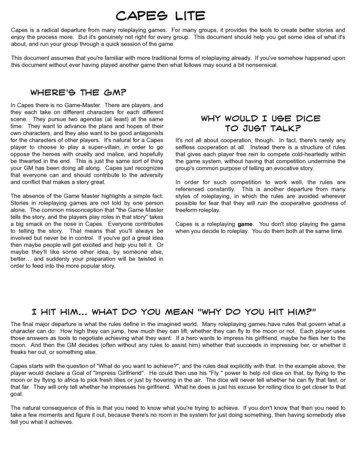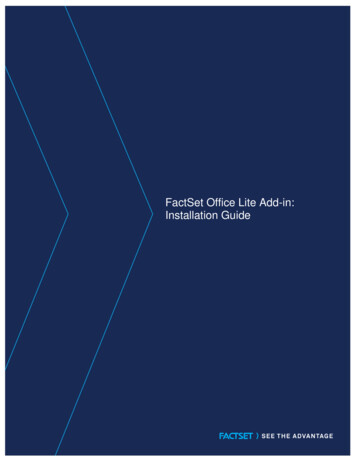
Transcription
Capes LiteCapes is a radical departure from many roleplaying games. For many groups, it provides the tools to create better stories andenjoy the process more. But it's genuinely not right for every group. This document should help you get some idea of what it'sabout, and run your group through a quick session of the game.This document assumes that you're familiar with more traditional forms of roleplaying already. If you've somehow happened uponthis document without ever having played another game then what follows may sound a bit nonsensical.Where's the GM?In Capes there is no Game-Master. There are players, andthey each take on different characters for each differentscene. They pursue two agendas (at least) at the sametime: They want to advance the plans and hopes of theirown characters, and they also want to be good antagonistsfor the characters of other players. It's natural for a Capesplayer to choose to play a super-villain, in order to gooppose the heroes with cruelty and malice, and hopefullybe thwarted in the end. This is just the same sort of thingyour GM has been doing all along. Capes just recognizesthat everyone can and should contribute to the adversityand conflict that makes a story great.The absence of the Game Master highlights a simple fact:Stories in roleplaying games are not told by one personalone. The common misconception that "the Game Mastertells the story, and the players play roles in that story" takesa big smack on the nose in Capes. Everyone contributesto telling the story. That means that you'll always beinvolved but never be in control. If you've got a great ideathen maybe people will get excited and help you tell it. Ormaybe they'll like some other idea, by someone else,better and suddenly your preparation will be twisted inorder to feed into the more popular story.Why would I use diceto just talk?It's not all about cooperation, though. In fact, there's rarely anyselfless cooperation at all. Instead there is a structure of rulesthat gives each player free rein to compete cold-heartedly withinthe game system, without having that competition undermine thegroup's common purpose of telling an evocative story.In order for such competition to work well, the rules arereferenced constantly. This is another departure from manystyles of roleplaying, in which the rules are avoided whereverpossible for fear that they will ruin the cooperative goodness offreeform roleplay.Capes is a roleplaying game. You don't stop playing the gamewhen you decide to roleplay. You do them both at the same time.I hit him. what do you mean "Why do you hit him?"The final major departure is what the rules define in the imagined world. Many roleplaying games have rules that govern what acharacter can do: How high they can jump, how much they can lift, whether they can fly to the moon or not. Each player usesthose answers as tools to negotiate achieving what they want: If a hero wants to impress his girlfriend, maybe he flies her to themoon. And then the GM decides (often without any rules to assist him) whether that succeeds in impressing her, or whether itfreaks her out, or something else.Capes starts with the question of "What do you want to achieve?", and the rules deal explicitly with that. In the example above, theplayer would declare a Goal of "Impress Girlfriend". He could then use his "Fly " power to help roll dice on that, by flying to themoon or by flying to africa to pick fresh lilies or just by hovering in the air. The dice will never tell whether he can fly that fast, orthat far. They will only tell whether he impresses his girlfriend. What he does is just his excuse for rolling dice to get closer to thatgoal.The natural consequence of this is that you need to know what you're trying to achieve. If you don't know that then you need totake a few moments and figure it out, because there's no room in the system for just doing something, then having somebody elsetell you what it achieves.
How does it fit together?Once you've got all these ideas firmly in mind (which can take a while), the structure of Capes is simple. The story is told inScenes, which are arbitrary divisions of "Let's do something here, with these characters, for a while". For instance, a scene at abank, with some heroes and some villains, is probably a robbery. Every player gets at least one character in each scene.Sometimes they play heroes, sometimes they play villains, sometimes they play bystanders.In each Scene there are Goals on the table: "Break into the vault", "Hurt Hostages", "Arrest Magnetron", "Impress Ace ReporterSheila Star" and so on. Each Goal has two sets of dice, one in favor of it succeeding, one in favor of it failing. When the Goalresolves, whichever side has the highest total on their dice triumphs. Either the Goal succeeds or it fails.But, of course, people want to change the values on those dice. They get Actions in order to do this. The Actions are organizedinto Pages. So a Scene is split up into Pages, and every Page each character gets an Action. They may use this Action todeclare a new Goal ("Hey, I just realized that I'm trying to convince Taurus to turn on his heroic allies and join us villains! Let'smake that a Goal!") Or, if they would rather, they may use one of their Abilities (like "Super-strength", "Escape without a Scratch",or "Obnoxious") to roll one of the dice that are out on the Goals. This lets them drive the values on their preferred side up, ordrive the values on the opposing side down.I can't let him kill peggy-sue. I just CAN't!Taken as a whole, players actions let them gain control of the Goals that mean most to them, often at the expense of Goals thatmatter less. In the bank robbery example above, for instance, the heroes have to decide whether it's more important to succeedin arresting the villain, or to thwart his plan to harm the hostages. They may very well not get to do both.Players show what is important to them and their characters by deciding what to act on. They also show what is important byStaking Debt for or against Goals. Debt is a resource (measured in chips or other tokens) that the characters gain each time theyuse their super-powers. It is, in essence, their moral responsibility to prove that they are worthy of their powers. As such it is botha resource and a penalty. Staking it on a Goal makes it much easier to win that Goal (since heroes and villains are always morepowerful when acting in accord with their principles). But having too much will make it hard to be effective (as the character isassailed with self-doubt).Actions and Stakes together make it easy to tell when a Goal is grabbing the interest of the play group. An interesting Goal willhave piles of debt, and high dice totals. An uninteresting one will have no debt, and a low total. And, again, there is no GameMaster. Players are rewarded for taking on that role by earning Story Tokens (useful for lots of things later in the game) wheneverthey are on the losing side of a Goal that is important to other players. In short, players get rewarded for being defeated by amorally vested character. So they are encouraged to challenge other characters in ways that play to their moral stature.Let's give it a whirlSo you've read the first two pages, and decided you want to introduce your group of players to Capes? Great! That's the onlysolid way to see whether it will really work for your group. The patterns that make Capes what it is emerge in play, so what youneed to do is to get them playing, even before you're done explaining the rules.This will put you in a position that's unknown in long-term Capes play. There is noGame Master in the Capes rules, no single player who is privileged over any others.But for the sake of getting your group playing quickly you will take the lead onimparting the rules and providing adversity. You will, in short, be doing many of thethings that a Game Master does in other games, until the other players learn enoughto take an equal part in doing so.So this document is written to give you the tools to boss people around and tell themwhat to do. And if you want to call the shots, you have to do some preparatory work.Gather the equipment in the box to the right.And last, but certainly not least, you need to cut out a whole batch of Click And Lockmodules. Go to the Downloads section of the Capes website:A package of 3x5 cards, for writingand tracking GoalsA lot of dice, the six-sided sugarcube variety, in two distinctcolors (assumed to be "red"and "blue" for the rest of thisdocument)A bunch of poker chips, or someother appropriate "token" forDebt.Pencils or penshttp://www.museoffire.com/Games/. and start printing. You can either print the entire Click and Lock PDF, or you can use the Flash character generator to createsheets with just the modules you think will be most interesting to the players in your game. But you should have enough for everyplayer to make several characters. Cut them out along the curvy, hard-to-cut lines, and then you're ready to play.
1Heroes are made,not born2First, let's figure outroughly who's on whichside. I can only play onevillain, and we don't wantthemtooterriblyoutnumbered in this firstscene. Hands up whoelse is going to play avillain,orpanickingbystander, or other sourceof trouble for our stalwartheroes?Once you have your players gathered together, you start thegame, using the shpiel at right. Keep it snappy, and keepthe players moving. If they start getting bogged downasking questions right now you'll waste a huge amount oftime explaining rules that are easier to see in context.If your group is four or more people (including yourself) thenyou'll also need to use the shpiel at left, to get a decentbalance of antagonists in order to make the first sceneinteresting. Once folks see the system in action they shouldget accustomed to providing that balance themselves (ornot, which can make for more dramatic scenes, once peoplehave the rules acumen to survive being outnumbered).Now that you've got everyone thinking about creatingcharacters for the scene at hand, you give them the tools todo so. Use the shpiel at right. Again, keep things snappyand don't give people too much opportunity to agonize overtheir options.Okay, folks, the game is playedin Scenes. I create the firstone, and it's an armed robberyat Nova Labs, the premieredeveloper of cutting-edgesuper-technology. You'll needa character in order to play, solet's make some. They'll needsome reason for being there,like they're trying to stealsomething, or they're trying tosave hostages, or they are ahostage.3You'll need a Persona, so whenthese get to you pick one andpass them on. Pick up thepersonae and pass them toyour right And you'll needeither super-powers or somemundane skills, so pick one andpass them on. Pick up thepowers and skills, and passthem to your left Let's getthose around the table quickly,and then I'll show you how tocombine them and fill them in.Assembling a CharacterChoose PowersGodlingCasually overpowermortalsSuper-strengthSuper-speedInspire AweInvulnerabilityLaser Eye-beamsDivert large flyingobjectsFlightChoose PersonaOnce everyone has a pair of modules in their hands, go to the shpiel below.Need I mention, by this point, that you want to keep people moving and notlet them get paralyzed by thinking too much?SeducerPoutSensualUnderstandingVindictive"You know you want to"SlyGreedyCombineGodlingSuper-strengthCasually r Eye-beamsFlightInspire Awe"You know you want to"Divert large SlyGreedyCross out threeGodlingSuper-strengthCasually r Eye-beamsFlightInspire Awe"You know you want to"Divert large SlyGreedyNumberGodlingSuper-strengthCasually r Eye-beamsFlightInspire Awe"You know you want to"Divert large SlyGreedy4So they click together like this, see? Now you have fifteen abilities inthree columns. The first thing you do is pick the three of those fifteenthat you like least, and just cross them off. Other characters withthese modules might have those abilities, but you don't. Ostentatiously cross of three things at random Now you numbereach column, starting from one and going up to as many abilities asyou have left in the column. It doesn't really matter how you numberthem. Off-handedly number your columns, starting from the bottomand proceeding straight up 1 2 3 4 and so on. Pencils downwhen you're done. Put your pencil down and look aroundexpectantly
Start things offwith a Bang!ScenePageOnce everyone has a character, you'll get into thefirst Scene. This will probably be the first place5 where people start really giving you strange looksOkay, each of us gets anabout how the system works. Again, playtests haveAction. On your Action youshown that the easiest way to get people over theircan do one of two things. I'llinitial discomfort is to move them through and todo the first thing, which is toprovide a good example of using the system.create a Goal. Take a 3x5card and write "Kill Hostages"Capes is closer in structure to a card or board-gameon it This is something mythan to many traditional roleplaying games. Itvillain wants to do. Here's aprovides an explicit turn order, with players actingdie for him. Place a red dieone after the other. And it makes clear who ison the card, with "1" facing up allowed to be narrating the happenings of the game.Some of you heroes may wantAs you guide players through the first scene, you'llto stop him. Here's a die forhave to shepherd them through this structure as well.you. Place a blue die on thecard, with "1" facing up In essence, the structure of play is a series ofEventually this will resolve, andrepeating loops, each nested within the next. Youwhen it does, whoever has theplay a Scene. Each Scene is made of Pages. Eachhigher value on their side willPage starts with Claiming Goals, then has Actionsget to narrate whether the(one for each character, generally), and ends withhostages live or die. UntilResolving Goals. Each Action either creates a Goal,then, nobody can narrateor uses an Ability. If it uses an Ability then the Actionanything that would resolve themay also have Reactions (up to one per player). Seeconflict. I can't kill hostages,the diagram at right.and you heroes can't save allof them. That's my Action.Happily, it's fairly easy to get people into thisNow I get to narrate what itimmediately.You'll teach them Actions, thenmeans in the game-world.Reactions (as applicable), then show them how Narrate, establishing yourActons are grouped together in Pages, and howvillain or villain-group's raid onPages form a Scene. Start with shpiel 5 at left.the lab, and their heartlessWhen you're done you should have something thatdisregard for innocent life (butlooks like the figure at right.short of killing anyone) Claim onActionResolve GoalsPagePageAfter Shpiel 5
Abilities beyond thoseof mortal men6I said you could do one of twothings with your Action. Nowyou to player at left cancreate a new Goal if you want.Or, you can do the secondthing, which is to use one ofyour character's abilities to tryto sieze control of an existingGoal.You've teased people with the fact that Actions cando one of two things. Before the next player takestheir action, describe what the other thing is, usingshpiel 6 to left.If players keep making up new Goals, just handlethem the same way you did the first one. They writesomething on an index card, and put a blue and reddie, starting at one. Eventually, however, someone isgoing to want to control some Conflicts. Use shpiel 7to right.If they pick an ability with a check-box next to it, useshpiel 8a at left. Otherwise use shpiel 8b below.8aSee this check box?Thatmeans this ability can only beused once in the Scene. Thoseother abilities, they're superpowers. They can be usedover and over, but each timeyou use them you take a DebtToken. If you have more thanfive it's bad, but it's easy anduseful to get rid of them.8bThis ability doesn't have any check box. Thatmeans that you can use it over and over, buteach time you use it you have to take a DebtToken. If you have more than five, you'll be introuble, but it's easy and useful to get rid ofthem. These other ones have check-boxes.You can use them for free, but you can only useeach one once in this Scene.7Okay, when you use an Abilityyou roll a die. Generally youcan roll any die, and choosewhether to accept the newvalue or turn it back to the oldone. That means you caneither roll your own die hopingto raise it, or an opposing diehoping to lower it. Right now,all the dice are ones. You can'tdrive the opposing side anylower, so you'll want to roll thedie on your own side, hoping toroll higher than a one and keepit. Generally you need to usean Ability that is of value equalto or greater than the currentvalue of the die you're rolling.Right now that die is a one, soany ability will do. So pick anability, and roll the die.Action and ReactionAs soon as a player rolls a die that is not a six, go onto explaining Reactions. If the die is four or five, useshpiel 9a, bottom left, otherwise use shpiel 9b,bottom right.9aNow every player has a chance to React on thisAbility roll. Reacting is just using another ability onthe same die. It doesn't cost you your action. Around of reactions is part of every ability roll thatgets accepted. Now you point to the player whorolled probably don't want to reroll this. Your oddsof getting much higher than you've already rolledaren't terribly good. But your opposition couldcertainly reroll it, trying to lower it. They'll need anability equal to or greater than your roll though, sothat can be tough to achieve. Anyone want toreact?9bNow every player has one chance to React on thisAbility roll. Reacting is just using another ability onthe same die. It doesn't cost you your action. Around of reactions is part of every ability roll thatgets accepted. Now you point to the player whorolled get the first opportunity, and you may wellwant to take it. You've got decent odds of raisingyour die. Or any of your team-mates might want toreact, to help you. Your opposition probably doesn'twant to react yet, trying to knock the die down.Their odds aren't very good right now. Anyone wantto react?
Filling in the details10Once you've got those rules in place, youcan probably sit back and play for a little bit.Your next "Rules-teaching" episode willhappen when one of two situations occurs.First, when somebody gets a second Debttoken. Read the monstrous shpiel 10 to theright, to introduce them to the concept ofStakes.You've got two Debt Tokens now. You can make good use of those, andhere's how. To get rid of Debt Tokens, you Stake them on your side of aGoal. You, personally, can Stake up to three tokens on any given Goal.That's gambling that you'll be able to make that goal go your way. If yourside eventually resolves the goal then you don't have to take those DebtTokens back. But if the other side resolves it, then you'll have to take backtwice as many. With me so far? Look around to make sure people havecaught on to the gambling aspect Okay, here's the advantage of beinginvested in a Goal. If there are more tokens bet on your side than it hasdice so in this case, two you can take a die and split its value, as evenlyas you can, over two dice. So you could take this four or whatever andsplit it into two twos or whatever . And then you still can only roll one dieper action, but your sides total is the total of the dice. So if lots of people arerolling them, you can get as much as a twelve total. Which will obviouslybeat anything that the other side could roll on only one die. Make sense?11Second, the turn will eventually come backaround to you (i.e. all players have had theirAction). When that happens, use shpiel 11to the rightt to introduce them to the conceptof Pages.Everyone has had an Action. That means Page number 1 is over. I startedPage 1, so he/she pointing to the player to your left starts Page 2. He'llget first Action, and then around the circle again, until it finally gets back tome. But first! At the start of Page 2, we get to determine which Goals mayresolve at the end of Page 2. We didn't do that for Page 1, because thereweren't any Goals on the table to choose from. Look at player to your left Is there any Goal that you'd particularly like to narrate the end of? Like, doyou want to have a chance to tell whether the Hostages live or die and how?12Continue asking around the table untilsomebody expresses an interest inresolving a Goal. Then use shpiel 12 to theright to introduce them to the concept ofClaiming.And that's that about Claiming, until you getto the end of Page 2. At the end of Page 2,it is very likely that there will be some Goalsready to be resolved. Use shpiel 13 at right,to introduce them to the basic concept ofResolving.You get dibs on your side of this Goal. You've Claimed it, for resolutionpurposes. You can only Claim one a Page. Nobody else can take it awayfrom you, though somebody may choose to Claim the opposing side as well.Now if your side controls the Goal at the end of this page, you'll be in chargeof resolving it. If nobody has claimed the side that controls a Goal then itdoesn't resolve this page.13That's the end of Page 2. Now we have some Goals to Resolve. See, youclaimed this side of this Goal, and that side is controlling it. So you get tonarrate how it all works out. Now. Go! What happens?14Once they're done with their narration, useshpiel 14 at right, to discuss Inspirations.If there was any Debt staked on the losingside, use shpiel 15a at right, to explain howthat gets dealt with.You also have to decide who gets Inspirations, and sometimes choose howmuch. They'll be useful in later Goals. You match dice on your side againstdice on the opposing side. If your die is more than a point higher you get anInspiration of yours, minus theirs. If their die is more than a point higher, youchoose someone on the opposition to get an Inspiration of theirs minusyours. So in this case your choices are describe choices, if any 15aYou point to the staking character Staked Debt on this and lost. So youget back twice as much Debt. Good for you!15bIf there was any Debt staked on the winningside, use shpiel 15b at right, to explain howthat gets dealt with.You point to a staking character Staked Debt on this and won. Now it's nolonger Debt. These are Story Tokens. You choose who, of the people whoopposed you, did a good job as opposition. Reward them accordingly, bygiving them the Story Tokens. No, you can't keep them for yourself.
As the pages turn16Once all the resolution is done, you'llpresumably be segueing directly into Page3. This is a good time to discuss StoryTokens. Use shpiel 16 at right.You may also need to explain the Overdrawrules (if any player has more than five DebtTokens that they haven't Staked). If so, useshpiel 17 at right.Claims happen again, and then Actions, andeventually someone who is about to take anAction will be holding an Inspiration. Useshpiel 18 at right, to inform them what theycan do with their Inspiration.Home stretch! You have one (yes, onlyone!) more shpiel to deliver. When a Pageends, and every single Goal on the tablegets resolved, that's the end of the Scene.Use the shpiel at bottom, and you will havetaught them all the rules of Capes Lite.Congratulations!Now you point have Story Tokens. They can do one of two things. First,at the beginning of a page like now you can start playing anothercharacter. You just make them up, or grab one from a previous scene, whenwe have previous scenes, and go. You'll get an Action for each character,so that's a lot of extra leverage. The other thing you can do is aftereveryone else has acted, you can spend a Story Token to take anotherAction on one of your characters. So taking a character now lets you getmore actions long-term, but saving your Story Tokens lets you get an actionwhen it really counts, right before Resolving Goals. Or, of course, you canhold them for later scenes. It's entirely up to you.17You point have more than five Debt Tokens. This is not a big deal, but it isa drag on your position. We take the highest die your character is allied with,and roll it. If it's higher, we turn it back to what it was. If it's lower, we leaveit. It's a recurring penalty that's particularly painful when you're doing well.18Before you jump into your action, let me point out what you can do with yourInspiration. Before or after the rest of your Action, you can spend thatInspiration to turn a die up to its value. So you can turn a one up to whatever , but you can't turn a six down to whatever . Particularly, if youwant to combine that with Debt, you could Stake, split a die into two smalldice, raise one with an Inspiration and roll the other one higher, all on yourone Action. Make sense?19Well, that's the last of the Goals. Our first scene is over. Nicely played! Nowyou turn to player at your left tell us where the next scene is, and we alldecide what characters we want to play for that. You can play the one fromthis scene, or make up a new one, or take a character someone else wasplaying, or whatever. If you have Story Tokens you can start out immediatelyplaying two or more characters. Now, where is the scene located? turn tothe player at your left and stare pointedly until they come up with something
and conflict that makes a story great. The absence of the Game Master highlights a simple fact: Stories in roleplaying games are not told by one person alone. The common misconception that "the Game Master tells the story, and the players play roles in that story" takes a big smack on the nose in Capes. Everyone contributes to telling the story.










